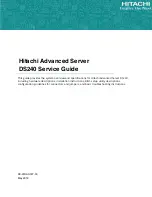
Memory
The SR590 server supports up to 8 TruDDR4 memory DIMMs with one processor and up to 16 DIMMs when
two processors are installed. Each processor has six memory channels, and there is a one DIMM per
channel for four channels and two DIMMs per channel for two channels for a total of 8 DIMMs per
processor.
Lenovo TruDDR4 memory uses the highest-quality components sourced from Tier 1 DRAM suppliers and
only memory that meets strict requirements is selected. It is compatibility tested and tuned on every
ThinkSystem server to maximize performance and reliability.
TruDDR4 memory has a unique signature programmed into the DIMM, which enables Lenovo servers to
verify whether the memory installed is qualified and supported. Lenovo qualified and supported TruDDR4
memory is covered by Lenovo warranty, and service and support provided worldwide.
The following rules apply when selecting the memory configuration:
The server supports RDIMMs and LRDIMMs.
Mixing different types of memory (RDIMMs and LRDIMMs) is not supported.
Mixing x4 and x8 RDIMMs and RDIMMs of different capacity is supported.
All DIMMs in the server operate at the same speed up to 2666 MHz, which is determined by the
maximum memory speed supported by the specific processor.
Note: Maximum memory speed can be achieved when Max performance mode is enabled in UEFI.
The following maximum memory capacities supported by the server:
RDIMMs: 512 GB (256 GB per processor).
LRDIMMs: 1024 GB (512 GB per processor).
The following memory protection technologies are supported:
ECC
SDDC (for x4-based memory DIMMs)
ADDDC (for x4-based memory DIMMs; Gold and Platinum processors only)
Memory mirroring
Memory rank sparing
Patrol scrubbing
Demand scrubbing
Single Device Data Correction (SDDC) works only in the independent channel mode (the default operational
mode) and supports only x4-based memory DIMMs.
Adaptive Double Device Data Correction (ADDDC) works with x4-based memory DIMMs and requires two
DIMM ranks per channel, Intel Xeon Gold or Platinum processors, and the Closed Page memory access
mode.
If memory mirroring is used, then DIMMs must be installed in quantities of 2 or 4 per processor for mirroring
across two memory channels, or 3 or 6 per processor for mirroring across three memory channels. All
DIMMs must be identical in type and size.
If memory rank sparing is used, then a dual-rank or quad-rank DIMM must be installed per populated
channel (the DIMMs do not need to be identical; single-rank DIMMs are not supported). In rank sparing
mode, one rank of a DIMM in each populated channel is reserved as spare memory. The size of a rank
varies depending on the DIMMs installed.
SDDC, memory mirroring, and memory rank sparing modes are mutually exclusive. Only one operational
memory mode can be enabled on the server, and it is a system-wide setting.
Lenovo ThinkSystem SR590 Server
22
















































